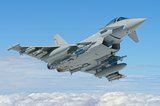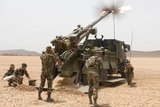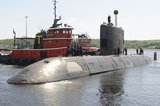Norway frigate collision due mainly to human factors: inquiry
A collision earlier this month between a Norwegian frigate and a Maltese oil tanker was mainly due to human factors, investigators said 29 November, ruling out a technical error at this stage.
Returning from NATO's Trident Juncture exercises, the KNM Helge Ingstad frigate sank after crashing into the Sola TS tanker in the early hours of 8 November, in a fjord near the western Norwegian town of Bergen.
Eight of the 137 people aboard the frigate received minor injuries.
‘As we see it, this is largely due to human factors,’ Dag Liseth of Norway's Accident Investigation Board told reporters as the preliminary findings into the cause of the accident were presented.
Investigators said the frigate's crew appeared to have confused the tanker with land, as the lights on the tanker - which was departing an oil terminal - blended together with the terminal's lights, and also made it impossible to see the tanker's navigation lanterns.
Another misunderstanding also occurred. The frigate ignored the tanker's warnings over the radio to veer starboard to avoid a collision, thinking the calls were coming from another vessel farther away in the fjord.
‘No isolated action or event caused the accident, but the accident can be explained by a series of compounded factors and circumstances,’ the accident board said in its preliminary assessment.
It also said it had no ‘indication at present that technical systems malfunctioned’.
Authorities are still trying to raise the 5,000-tonne vessel, which is almost entirely submerged.
More from Naval Warfare
-
![First made-in-Finland US Coast Guard Arctic Security Cutter to be delivered in 2028]()
First made-in-Finland US Coast Guard Arctic Security Cutter to be delivered in 2028
The first Arctic Security Cutter will be built by Rauma Marine Constructions to be deployed in the US Arctic waters.
-
![Is the US Navy’s Golden Fleet initiative achievable?]()
Is the US Navy’s Golden Fleet initiative achievable?
The effort to provide the US Navy with Trump-class battleships might face financial, production and doctrinal obstacles.
-
![Will the US Navy surge production for OTH-WS missile?]()
Will the US Navy surge production for OTH-WS missile?
The USN is conducting a market search seeking additional sources capable of supplying 516 units of Over the Horizon – Weapons System Encanistered Missiles.
-
![Thales wins DE&S contract for portable autonomous command centres]()
Thales wins DE&S contract for portable autonomous command centres
The agreement to provide portable autonomous command centres to the UK Royal Navy will enhance the service’s Mine Counter Measure operations and further integrate autonomous and uncrewed systems into its fleet.
-
![Maritime defence in the Mediterranean faces challenges from vulnerable land power]()
Maritime defence in the Mediterranean faces challenges from vulnerable land power
As an indispensable energy crossroads, the Mediterranean is at serious risk from grey zone disruption. As navies increasingly employ AI data centres, what happens when cutting-edge defence technologies rely on the very infrastructure most susceptible to hybrid tactics?
























